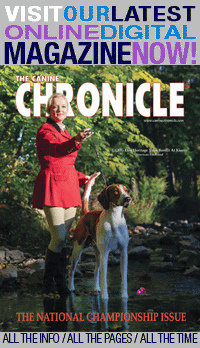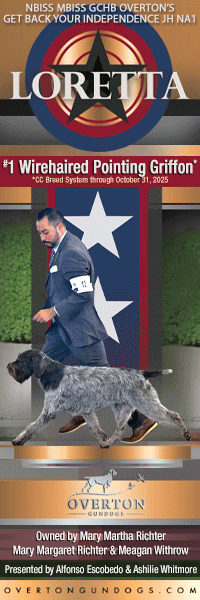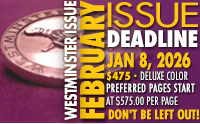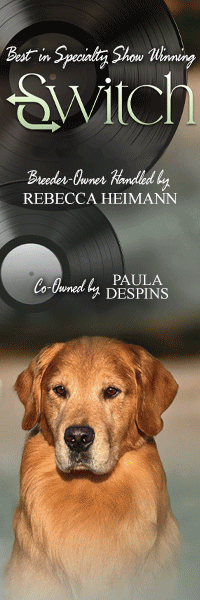Breed Priorities – Bull Terriers
Click here to read the complete article
By Nikki Riggsbee
 Understanding a breed’s priorities is essential to understanding type and to successfully evaluating dogs, whether as a breeder or a judge. Some standards assist in this area more than others. The Bull Terrier, shown as two varieties – white and colored – has some very distinct features, some of which experts consider essential.
Understanding a breed’s priorities is essential to understanding type and to successfully evaluating dogs, whether as a breeder or a judge. Some standards assist in this area more than others. The Bull Terrier, shown as two varieties – white and colored – has some very distinct features, some of which experts consider essential.
Thirty-five Bull Terrier breeder-judges were invited to participate in a survey to identify their breed’s priorities. Twenty-four accepted the invitation, and seventeen Bull Terrier breeder-judges returned the completed survey. Sixteen surveys ranked the virtues and faults; one only placed the outlines. The group averaged over thirty years in the breed and nearly fifteen years judging the breed. All have judged Bull Terrier specialties and almost all have judged the national specialty. The survey contributors came from all areas of the country. Some judge the Terrier group and some judge other groups as well; some judge multiple terrier breeds; others judge only Bull Terriers.
Bull Terrier Virtues
The breeder-judges were sent a list of breed characteristics from the Bull Terrier standard to prioritize from most important to least important. Below is the list of Bull Terrier characteristics in sequence by the average priority of the breeder-judges, “1” being the most important.
1. Full face…oval in outline…filled completely
2. Strongly built, muscular, symmetrical
3. Eyes small, triangular, obliquely placed
4. Body…well-rounded with marked spring of rib
5. Back…short and strong…slight arch over loin
6. Great depth from withers to brisket
7. Legs…big boned…not coarse
8. Full of fire but of sweet disposition
9. Ears small…capable of being held stiffly erect…point upwards
10. Stifle joint…well bent
11. Hocks well let down
12. Fore and hind legs…move parallel to each other
13. Feet…like a cat
14. Teeth…either level or scissors bite
15. Tail…short, set on low…carried horizontally
16. Skin should fit tightly
This group of experts was most consistent on the highest priority, “Full face…oval in outline…filled completely” (1st). All but one ranked it in the top quartile, and more than sixty percent ranked it first. More than eighty percent also agreed on “strongly built, muscular, symmetrical” (2nd) and “skin should fit tightly” (16th).
Almost as many concurred on “Teeth…either level or scissors bite” (14th); bite is not a big priority in this breed compared to other features. Almost as many experts agreed on “Body…well rounded with marked spring of rib (4th), “Great depth from withers to brisket” (6th), “Legs…big boned…not coarse” (7th), “Stifle joint…well bent” (10th), “Hocks well let down” (11th), and “Tail…short, set on low, …carried horizontally” (15th).
Ten experts similarly valued “Eyes small, triangular, obliquely placed” (3rd) and “Feet…like a cat” (13th). The smallest majority thought alike about “Back…short and strong…slight arch over loin” (5th) and “Fore and hind legs…move parallel to each other” (12th). Overall, there was much consistency, with fourteen characteristics having majority agreement.
There were split decisions on three characteristics, including “Fore and hind legs…move parallel to each other” (12th), which had a majority. Nine had it in the bottom quartile, but six had it closer to middling importance which raised the rank.
Right in the middle were “Full of fire but of sweet disposition” (8th) and “Ears small…capable of being held stiffly erect…point upwards” (8th). On “Temperament”, seven had it near the top, but four had it near bottom. “Ears” weren’t split quite as dramatically; seven had it below average in importance, six were higher.
Some averages were so close that more input could easily change the ranking. “Body…well rounded with marked spring of rib” (4th) and “Back…short and strong…slight arch over loin” (5th) were very close in average rank. Only a fraction separated “Fore and hind legs…move parallel to each other” (12th) and “Feet…like a cat” (13th).
Bull Terrier Faults
The judges also ranked a set of faults from most serious to least serious. The ranked faults are not all the inverse of the virtues; most faults are specified in or derived from the standard. Here is the list in sequence by the judges’ average priorities, starting with most serious.
1. Head not egg-shaped…in profile not curving gently downward
2. Narrow chest…lacking great depth
3. Large eyes, not triangular
4. Crooked front legs
5. Slackness or dip at the withers
6. Not moving compactly and in one piece
7. Flat or splayed feet
8. Legs not moving parallel to each other
9. Light brown eyes
10. Neck short or not muscular
11. Large, thick ears
12. Nose not bent downward at tip
13. High-set tail
14. Teeth not meeting in a level or scissors bite
15. Gay tail carriage
16. Small marking on the body of a white dog
As with the virtues, the judges were most consistent on the most serious faults and the least serious ones, although there were fewer with majorities.
The most consistently placed fault was the one ranked first: “Head not egg-shaped…in profile not curving gently downward;” all but three surveys placed it first. Head type is unequivocally critical for this breed. Thirteen agreed on “Small marking on the body of a white dog” (16th), although the standard said such markings should be “severely faulted.”
There was also agreement on “Narrow chest…lacking great depth” (2nd) and “Gay tail carriage” (15th). Eleven experts concurred on “Slackness or dip at the withers” (5th). Ten surveys valued these two traits similarly: “Large eyes, not triangular” (3rd) and “Not moving compactly and in one piece” (6th).
Bare majorities concurred on these faults: “Flat or splayed feet” (7th), “Neck short or not muscular” (10th) and “Teeth not meeting in a level or scissors bite” (14th).
Four faults garnered half the breeder-judges in agreement. These were “Crooked front legs” (4th), “Legs not moving parallel to each other” (8th), “Large, thick ears” (11th), and “High-set tail” (13th).
“Light brown eyes” (9th) had six rank it mid-serious or more so, while the same number had it near bottom. “High-set tail” (13th) had half place it middling, but six considered it much less of a problem. “Nose not bent downward at tip” (12th) was below average for six, but the rest had it all over, from second to sixteenth.
Some rankings were fairly close. Fourth “Crooked front legs” (4th) and “Slackness or dip at the withers” (5th) were less than one-tenth of a point apart.
On the other hand, “Head not egg-shaped” (1st) was more than two-and-a-half points more serious than second place, emphasizing its position as first. Over three points separate “Movement” (6th) and “Bad feet” (7th), confirming that the first six are distinctly more serious than the rest.
The breeder-judges were asked to specify four to six essential characteristics that a good Bull Terrier must have.
By far the most consistent characteristic named by the judges was the head, including the profile, fill, and “varminty” eyes. Frequently mentioned also were carriage and movement, balance, and bone and substance. Type was either mentioned specifically or by naming its components of head and body shape.
Outlines
The breeder-judges placed six Bull Terrier dogs and six Bull Terrier bitches based on their outlines only. The outlines were made from photos of real dogs, so none is perfect. They are all good dogs, with different strengths. Before reading further and using the priorities above, select your Best of Breed from the Bull Terrier outlines.
The judges’ placements were averaged to determine their collective selections. Top male was Bull Terrier “E,” who had the best average placement and more first place scores than any other. Those who liked “E” said he had “good head and balance,” “good depth, length of neck…short back,” “straight topline,” correct tail set and carriage, “terrier type,” “square,” and “good forechest.”
The next favorite male was Bull Terrier “F.” Among the reasons for selecting “F” were “most breed type, most dog,” “overall balance, short back, correct topline and tail set,” “upstanding, athletic, proper downface,” “good make and shape,” and “strength in head, depth of quarters.”
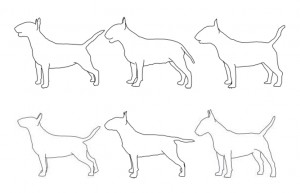 The Bull Terrier bitch with the highest average placement was bitch “X.” The breeder-judges who chose her commented that she had “lovely head and neck, good bone, and well-balanced,” “tidy well-set ears, excellent tail set, graceful underline,” and “deep chest, ample body volume, with bone/substance aplenty.”
The Bull Terrier bitch with the highest average placement was bitch “X.” The breeder-judges who chose her commented that she had “lovely head and neck, good bone, and well-balanced,” “tidy well-set ears, excellent tail set, graceful underline,” and “deep chest, ample body volume, with bone/substance aplenty.”
Very close behind “X” was Bull Terrier bitch “U.” Those who liked her described her as having a “lovely head, well placed neck and shoulders, and she was balanced,” “good forechest, decent bone and substance,” “great spring of rib, great feet with super pasterns,” and “most classic lines, most type.” Bitch “U” had more first place rankings than did bitch “X,” though, so perhaps they effectively tied.
The Best of Breed Bull Terrier based on the highest average score was dog “E,” although dog “F” was placed Best by one more breeder-judge than “E”. Only two bitches were selected BOB more than once. Bitch “X” was picked three times; bitch “V” (who was only fourth place among the bitches) was picked twice, so those judges who liked her must have really liked her.
Dog “E” placed first eight times, dog “F” seven times. Bitch “U” was placed first by six breeder-judges, bitch “X” five times. Dog “A” and bitch “W” were out of the ribbons most often. All of the outlines except “E” were unplaced by at least two experts. All dogs were placed first at least once except for dog “A.” All bitches were placed first at least once except “W.”
Additional Comments
Several of the judges included comments for students of their breed.
• Bull terriers are made of three very different phenotypes: Bulldog, white English terrier (like a white Manchester), and Dalmatian. It is very difficult to produce an animal that has the bone, substance, and musculature of the Bulldog, the quick athleticism of the English terrier, and the elegance and style of the Dalmatian.
• Head shape and fill are important in Bull Terriers; if they are good, the ears, eyes, and teeth are relatively secondary.
• Judges who excuse colored dogs for white patches on their backs seem to be creative in interpreting the standard.
• Judges who think BT’s should be statues will be disappointed. Some are better trained than others, but they are clownish and love a party. Their temperaments are mostly wonderful! They have grand senses of humor. Judges should enjoy seeing a Bull Terrier and want to smile along with them.
• One must judge the breed on strength of virtues because type will degrade to a “normal” type of bull-terrier cross very easily if you do not.
• An extremely sound dog without the proper BT head should not place.
• Type: it should stare at you front on and burn holes through your chest.
Thanks to the Bull Terrier breeder-judges for sharing their knowledge.
Short URL: http://caninechronicle.com/?p=98078
Comments are closed
